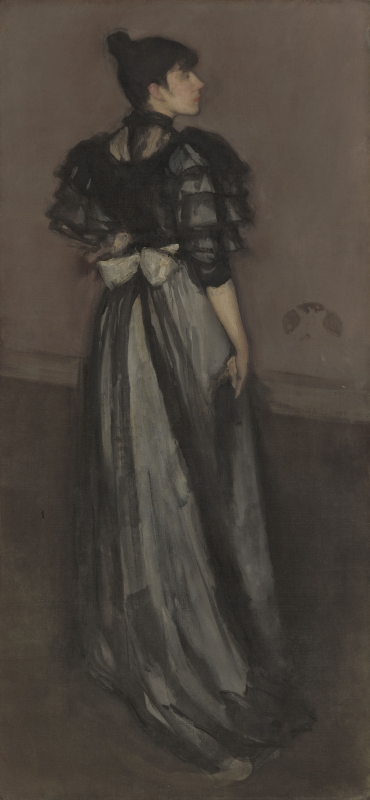Home > Catalogue > Browse > Mother of Pearl and Silver: The Andalusian << >>
Titles
Various descriptive titles were used by Whistler and others, as follows:
- 'the girl ... in black or grey' (1896, E. G. Kennedy). 1
- 'the Black and grey one' (1896, Whistler). 2
- 'Spanish lady' (1896, Whistler). 3
- 'the one in black and mauve' (1896, E. G. Kennedy). 4
- 'The "Andalouse" ' (1900, Whistler). 5
- 'Mother-of-Pearl and Silver - The Andalusian' or ' "Nacre et Argent", l'Andalouse' (1900, Exposition Universelle, Paris). 6
- 'Mother of Pearl and Silver: The Andalusian' (1980, YMSM). 7
'Mother of Pearl and Silver: The Andalusian' is based on the title used for the 1900 exhibition, with punctuation regularised to conform with other titles.
Description
A full length portrait of a woman, in vertical format. She is seen from the back, standing, and turning slightly to the right, so that her face is in profile to right. At the bottom of the canvas, her skirt swirls around to the right. She has dark brown hair swept up into a bun, and a fringe that curves over her eyebrows. Her dress is grey ('silver') and tied at the back with a pale grey bow at the waist. The top of the dress is dark grey, close fitting, with a low rounded neckline, under a high-necked thin black gauze (or net) top. The three-quarter length sleeves are embellished with four lavish frills of this thin gauze. Her right arm hangs at her side, holding a scarf or gloves; her left arm is not visible. She stands on a grey/brown floor, leading to a warm grey/mauve wall: the wall recedes to left, as indicated by the diagonal line of the narrow skirting board from lower right to upper left. The painting is signed on the wall with a slightly darker butterfly at right.
Sitter
This is one of several portraits of Ethel Whibley (1861-1920). Mother of Pearl and Silver: The Andalusian was being painted at the same time as other portraits, including Red and Black: The Fan [YMSM 388].
Whistler took a close interest in women's dress, and the clothes worn by Ethel Philip (Mrs Whibley) in his portraits follow the latest fashions. As she did not have a large income, they were probably copies of couture outfits, inspired by magazine illustration, and could have been made up by her dressmaker. 8
The National Gallery of Art website comments:
'Ethel Birnie Philip, daughter of a sculptor, married in 1895. The next year saw the death of her sister, who was Whistler's wife. This elegant depiction of light gleaming in the dark, though, represents neither a bride nor a mourner. Whistler firmly stated, "Art should be independent of clap-trap – should stand alone, and appeal to the artistic sense of eye or ear, without confounding this with emotions entirely foreign to it, as devotion, pity, love, patriotism and the like." ' 9
Comments
The National Gallery of Art website emphasized Whistler’s links with Diego Rodriguez de Silva y Velázquez (1599-1660):
'Whistler claimed to excel Diego Velazquez, the seventeenth-century master from Andalusia, Spain. What creates the somber, Spanish mood in Whistler's Andalusian are the haughty beauty's backward swerve as well as the cool grays and warm tans that shimmer through her gown's black net fabric. The outfit, however, is no more Spanish than the model. Her layered sleeves and chignon, fashionable internationally during the 1890s, are worn here by Whistler's English sister-in-law, Ethel Birnie Philip.' 10
In fact Whistler never claimed to excel Velázquez, but he did comment ironically, when someone told him that he and Velasquez were the only two painters in the world, 'Why drag in Velasquez?' 11
Furthermore, there are many aspects of the composition, treatment of paint and colour that are reminiscent not only of Velasquez, but of Francisco José de Goya y Lucientes (1746-1828). 12
Notes:
1: Kennedy to Whistler, 25 February 1896, GUW #07266.
2: Whistler to E. G. Kennedy, [14 March 1896] and [28 March 1896], GUW #09738, #09739.
3: Whistler to E. G. Kennedy, [28 June 1896], GUW #09761.
4: Kennedy to Whistler, 4 September 1896, GUW #07280.
5: Whistler to Kennedy, [12 May 1900], GUW #09800.
6: Exposition Universelle, Grand Palais, Paris, 1900 (cat. no. 46).
7: YMSM 1980 [more] (cat. no. 378).
8: MacDonald 2003 [more], pp. 196-201, 205-07.
9: National Gallery of Art website http://www.nga.gov.
10: Ibid.
Last updated: 19th April 2021 by Margaret






